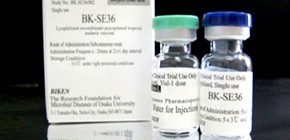
OU-developed vaccine lowered the number of people infected by malaria by 72 percent
Under the leadership of HORII Toshihiro , Professor, Research Institute for Microbial Diseases, Osaka University, a group of researchers conducted phase 1b clinical trial of BK-SE36 malaria vaccine in Uganda. Although the trial was not designed to detect efficacy, it appears the vaccine lowered the number of people infected by malaria by 72 percent. If true, the effectiveness of this vaccination is much higher than any other malaria vaccine previously developed and this group's achievement shows promise of leading to a drastic reduction in fatalities in tropical malaria that has taken hold in tropical and sub tropical areas.
Abstract
Background
Up to now a malaria vaccine remains elusive. The Plasmodium falciparum serine repeat antigen-5 formulated with aluminum hydroxyl gel (BK-SE36) is a blood-stage malaria vaccine candidate that has undergone phase 1a trial in malaria-naive Japanese adults. We have now assessed the safety and immunogenicity of BK-SE36 in a malaria endemic area in Northern Uganda.
Methods
We performed a two-stage, randomized, single-blinded, placebo-controlled phase 1b trial (Current Controlled trials ISRCTN71619711). A computer-generated sequence randomized healthy subjects for 2 subcutaneous injections at 21-day intervals in Stage1 (21–40 year-olds) to 1-mL BK-SE36 (BKSE1.0) (n = 36) or saline (n = 20) and in Stage2 (6–20 year-olds) to BKSE1.0 (n = 33), 0.5-mL BK-SE36 (BKSE0.5) (n = 33), or saline (n = 18). Subjects and laboratory personnel were blinded. Safety and antibody responses 21-days post-second vaccination (Day42) were assessed. Post-trial, to compare the risk of malaria episodes 130–365 days post-second vaccination, Stage2 subjects were age-matched to 50 control individuals.
Results
Nearly all subjects who received BK-SE36 had induration (Stage1, n = 33, 92%; Stage2, n = 63, 96%) as a local adverse event. No serious adverse event related to BK-SE36 was reported. Pre-existing anti-SE36 antibody titers negatively correlated with vaccination-induced antibody response. At Day42, change in antibody titers was significant for seronegative adults (1.95-fold higher than baseline [95% CI, 1.56–2.43], p = 0.004) and 6–10 year-olds (5.71-fold [95% CI, 2.38–13.72], p = 0.002) vaccinated with BKSE1.0. Immunogenicity response to BKSE0.5 was low and not significant (1.55-fold [95% CI, 1.24–1.94], p = 0.75). In the ancillary analysis, cumulative incidence of first malaria episodes with ≥5000 parasites/µL was 7 cases/33 subjects in BKSE1.0 and 10 cases/33 subjects in BKSE0.5 vs. 29 cases/66 subjects in the control group. Risk ratio for BKSE1.0 was 0.48 (95% CI, 0.24–0.98; p = 0.04).
Conclusion
BK-SE36 is safe and immunogenic. The promising potential of BK-SE36, observed in the follow-up study, warrants a double-blind phase 1/2b trial in children under 5 years.


Figure 1
Figure 2


Figure 3

Figure 4
To learn more about this research, please read the full research report entitled " Phase 1b Randomized Trial and Follow-Up Study in Uganda of the Blood-Stage Malaria Vaccine Candidate BK-SE36 " at this page of the PLOS ONE website.
Related links :

